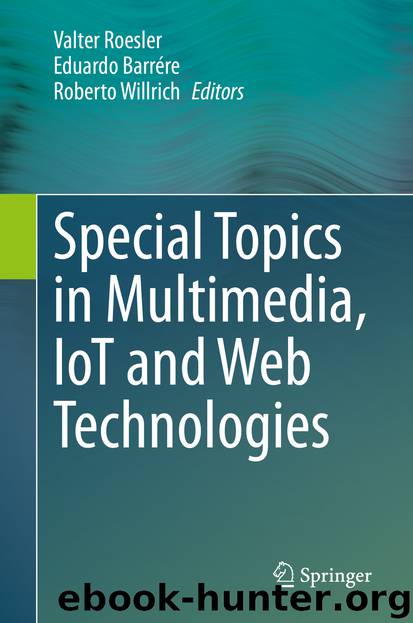Special Topics in Multimedia, IoT and Web Technologies by Valter Roesler & Eduardo Barrére & Roberto Willrich

Author:Valter Roesler & Eduardo Barrére & Roberto Willrich
Language: eng
Format: epub
ISBN: 9783030351021
Publisher: Springer International Publishing
Another important aspect to be considered in a smart space is user mobility. Smart spaces should support mobility and integrate computational techniques and devices to enable user interaction with the environment in a transparent and intuitive manner [35].
Research in the area of the smart spaces is quite robust. For more than a decade, researchers have been proposing solutions for the field, such as the work of Johanson and Fox [27], who propose the Event Heap, a collaborative workspace that extends the TSpaces, a tuple space presented by IBM Research [72], in which different applications can publish and receive events of their interest.
Coen et al. [11] present Metaglue, a Java-based programming language developed in the artificial intelligence laboratories of the Massachusetts Institute of Technology (MIT). The goal of Metaglue is to enable the development of smart space applications by supporting a number of specific needs of this type of application, such as interconnecting and managing heterogeneous hardware and software, adding, removing, modifying, and updating components in a system at runtime, as well as controlling the allocation of resources.
More recently, the works in the smart spaces field that have attracted attention are the open source initiatives: openHAB1 and Smart-M3.2 The openHAB (open Home Automation Bus) project aims to provide a universal integration platform for home automation. openHAB is a Java solution, completely based on OSGi,3 which facilitates its goal of enabling the hardware interconnection from several vendors, even if they use different communication protocols. Smart-M3 is a platform that offers distributed applications a shared view of information and services present in ubiquitous environments, based on the blackboard architectural model. Smart spaces are seen as information providers and the applications that make up the smart spaces, in turn, produce and consume information.
The traditional smart spaces discussed in this subsection are referred in this chapter as fixed smart spaces. In distinction to them, the concept of personal smart spaces is presented as follows.
Download
This site does not store any files on its server. We only index and link to content provided by other sites. Please contact the content providers to delete copyright contents if any and email us, we'll remove relevant links or contents immediately.
Grails in Action by Glen Smith Peter Ledbrook(9163)
Sass and Compass in Action by Wynn Netherland Nathan Weizenbaum Chris Eppstein Brandon Mathis(8808)
Azure Containers Explained by Wesley Haakman & Richard Hooper(7444)
Configuring Windows Server Hybrid Advanced Services Exam Ref AZ-801 by Chris Gill(7433)
Kotlin in Action by Dmitry Jemerov(7263)
Running Windows Containers on AWS by Marcio Morales(6984)
Microsoft 365 Identity and Services Exam Guide MS-100 by Aaron Guilmette(5402)
Microsoft Cybersecurity Architect Exam Ref SC-100 by Dwayne Natwick(5212)
Combating Crime on the Dark Web by Nearchos Nearchou(4982)
The Ruby Workshop by Akshat Paul Peter Philips Dániel Szabó and Cheyne Wallace(4670)
Management Strategies for the Cloud Revolution: How Cloud Computing Is Transforming Business and Why You Can't Afford to Be Left Behind by Charles Babcock(4527)
Python for Security and Networking - Third Edition by José Manuel Ortega(4233)
The Age of Surveillance Capitalism by Shoshana Zuboff(4209)
Learn Wireshark by Lisa Bock(4119)
The Ultimate Docker Container Book by Schenker Gabriel N.;(3888)
Learn Windows PowerShell in a Month of Lunches by Don Jones(3681)
DevSecOps in Practice with VMware Tanzu by Parth Pandit & Robert Hardt(3568)
Windows Ransomware Detection and Protection by Marius Sandbu(3541)
Blockchain Basics by Daniel Drescher(3507)
